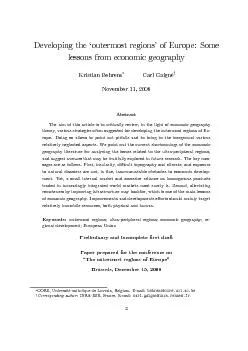/


Download Pdf The PPT/PDF document "Developingthe" is the property of its rightful owner. Permission is granted to download and print the materials on this web site for personal, non-commercial use only, and to display it on your personal computer provided you do not modify the materials and that you retain all copyright notices contained in the materials. By downloading content from our website, you accept the terms of this agreement.
DevelopingtheoutermostregionsofEurope:SomelessonsfromeconomicgeographyKristianBehrensCarlGaignéNovember11,2006AbstractTheaimofthisarticleistocriticallyreview,inthelightofeconomicgeographytheory,variousstrategiesoftensuggestedfordevelopingtheoutermostregionsofEu-rope.Doingsoallowstopointoutpitfallsandtobringtotheforegroundvariousrelativelyneglectedaspects.Wepointoutthecurrentshortcomingsoftheeconomicgeographyliteratureforanalyzingtheissuesrelatedtotheultra-peripheralregions,andsuggestavenuesthatmaybefruitfullyexploredinfutureresearch.Thekeymes-sagesareasfollows.First,insularity,diculttopographyandclimate,andexposuretonaturaldisastersarenot,inne,insurmountableobstaclestoeconomicdevelop-ment.Yet,asmallinternalmarketandexcessiverelianceonhomogenousproductstradedinincreasinglyintegratedworldmarketsmostsurelyis.Second,alleviatingremotenessbyimprovinginfrastructuremaybackre,whichisoneofthemainlessonsofeconomicgeography.Improvementsanddevelopmentseortsshouldmainlytargetrelativelyimmobileresources,bothphysicalandhuman.Keywords:outermostregions;ultra-peripheralregions;economicgeography;re-gionaldevelopment;EuropeanUnionPreliminaryandincompleterstdraftPaperpreparedfortheconferenceonTheoutermostregionsofEurope"Brussels,December15,2006 CORE,UniversitécatholiquedeLouvain,Belgium.E-mail:behrens@core.ucl.ac.beCorrespondingauthor:INRA-ESR,France.E-mail:carl.gaigne@inra.rennes.fr 1StructuralhandicapsandpossiblepolicyvectorsWhenanalyzingthestructuralhandicapsoftheultra-peripheralregions,arststepconsistsinseparatingthosefactorsthatcanbeimproveduponbyeconomicpolicyfromthosethatcannot.Inthelightofthis,thestructuralhandicapsoftheultra-peripheralregionscanberoughlyclassiedasfollows:1.Beyondthereachofeconomicpolicyandhumandesign:insularity;diculttopogra-phyandclimate;naturaldisasters2.Partlyinthereachofeconomicpolicyandhumandesign:remoteness3.Inthereachofeconomicpolicyandhumandesign:economicsize;dependenceonafewproductsPreviewingthesubsequentdevelopments,afewremarksareinorder.First,althoughthefactorsintherstcategoryarebeyondthereachofeconomicpolicyandhumandesignandmust,therefore,betakenasgiven,theydonotconstituteperseaninsurmountableobstacletoeconomicdevelopment.Indeed,severalregionsoftheworldcharacterizedbyinsularity,diculttopographyandclimate,andexposuretonaturaldisas-ters,haveovercometheseobstaclesanddevelopedquiterapidly.Keepingthisqualicationinmind,wewillnotsayanythingmoreonthisissueintheremainderofthispaperaswefocusonpolicy-baseddevelopmentstrategies.Second,thefactorinthesecondcategoryhasthestrongestgeographicalavor:remote-.Thisfactorcanbepartlyimprovedupon,atleastfromaneconomicperspective,bygraduallyreducingthefrictionstomovinggoods,people,andinformationviainfrastructureandinformationandcommunicationtechnologies(ICT).Doingsomay,however,backasreducingspatialfrictionsusuallyaectsbothdirectionsofmovementandmay,there-fore,leadtoquiteunexpectedresults.Thisaspecthastobeborneinmindwhendesigningeconomicpolicyandconstitutesoneofthemainmessagesofthispaper.Therealchal-lengeconsiststherefore,inouropinion,inimprovinguponthefactorsinthelastcategory.Theseareclearlywithinthereachofeconomicpolicy,eventhoughhistorytellsusthateconomicsizeissomethingverydiculttoaectgiventhestrengthofmarketmechanisms.Thus,aspecialfocusshouldrestupontheproductrange,whichmayserveasacatalyst Japanisanespeciallyilluminatingexampleofacountryhavingdevelopedrapidlydespitecombin-inginsularity,diculttopography,andexposuretonaturaldisasters.Severalotherislands,cumulatingthesamestructuralhandicapsthantheoutermostregionsofEurope,havepartlydevelopedbyoeringfavorablenancialandscalenvironments(e.g.,CaymanIslands,IsleofMan,Bahamas).Becausetheultra-peripheralregionsareanintegralpartoftheEuropeanUnion,suchadevelopmentstrategybasedonpreferentialscalconditionsisnotavailableasitisincompatiblewiththesinglemarket. 2.1EuropeanintegrationandthefortresseectEveninaworldwheretradecoststakelowvalues,itshouldbeclearthateconomicremote-nessremainsarelativeconcept:amarketismoreorlessremotewhencomparedtoanothersetofmarkets.Consequently,anychangeinthegeographyofdemandorsupplybetweentworegionsinthesetofmarketshasadirectimpactonalltheotherregionsbyaectingthecompetitiveenvironmentthere(thirdcountryeects;Behrensetal.,2005).Thisrelativ-ityofremotenessisespeciallyimportantinassessinghowtheEuropeanintegrationprocessisboundtoaecttooutermostregions.Indeed,thisintegrationprocesslargelychangesalltherelationshipsbetweentheregionalmarketsasbarrierstotradearegraduallyremovedandasnewmemberstatesjointheEU.AlthoughthespecicitiesoftheoutermostregionshavebeenacknowledgedbyArticle299.2oftheAmsterdamTreaty,theongoingintegrationprocessisalmostsurelyboundtohurttheseregionsexportperformance.ThereasonisthateconomicintegrationseemstoproceedmorerapidlywithincontinentalEuropethanbetweenEuropeandtheoutermostregions,therebyplacingthematacompetitivedisad-vantagebytransformingEuropemoreandmoreintoaFortress"thatisimpenetrableforexportsfromtheultra-peripheralregions.Insomesense,onemayarguethatwefaceasemanticandeconomicparadoxsincetheultra-peripheral(situatedontheedge)regionsareconsideredasbeingpartofthe(situatedontheinside)market.AconsequenceoftheincreaseddicultiesforremotelylocatedrmstopenetratetheEuropeanmarketisthatforeignFDIintotheEU,aswellasintra-EUFDI,hasincreased(Dunning,1997).Yet,themainrecipientsofFDIarelocatedclosetotheEuropeancoremarkets,whichthenserveasanexportplatformforservingtherestoftheinternalmarket(e.g.,Ireland).Anydeepeningintegrationoftheultra-peripheralregionsandtheEuro-peancontinentthenallowsthosemultinationalstoservetheoutermostregionsusingtheirproductionsitesasexportplatforms.Tosummarize,Europeanintegrationandtheeasternenlargementcertainlyadverselyaf-fectstheaccessoftheultra-peripheralregionstothelargeEuropeancoremarkets.Whetherstructuralspendingoninfrastructure,transportationtechnologiesandICTallowtopartlyalleviatethisproblemismorethanquestionable.Itis,indeed,unlikelythattherelativeac-cessoftheoutermostregionsimproveswhencomparedtoeithertheoldorthenewmemberstates. HeadandMayer(2001)analyzetheFortressEurope"eectbyfocussingonhowEuropeanintegrationectstheexportperformanceofU.S.andJapanesermsinalargenumberofsectors. Summaryresults.Tosummarizetheargumentspertainingtoremoteness-reducingpoli-cies,oneshouldkeepinmindthatitisprobablyillusorytoexpecttoattractfootloseac-tivitiestotheoutermostregionsbyimprovingtransportationlinks(whichmaynotevenbepossibleintherstplace).Onthecontrary,therelocationofsuchactivitiestotheEuropeancontinentisthemorelikelyoutcomegiventhecurrentcongurationandtheprevailingmarketforces.GiventheincreasingintegrationoftheEuropeanmarket,onepossibilityfortheultra-peripheralregionswouldbetorecentertheiractivityontyingcloserlinkswiththetradingpartnersintheirgeographicalareas.Aprotablestrategycouldbetofavoreconomicintegrationwiththeneighbouringcountriesandtoincreasingtheaccesstoothertradingareas,whichareclosetoSouthAmericaandtheACPcountries(African,CaribbeanandPaciccountries).JustasHong-KonginthecaseofChina,theoutermostregionscouldplaytheroleofnodeslinkingthesedierenttradingagreementsareprovidingtranshipmentanddistributionservices.Hence,asarguedbelow,infrastructureshouldbeaimedatfacilitatingtheexportsofgoodsandservicesproducedwiththehelpofimmobilelocalfactors.3Increasingmarketsize:ahopelessendeavor?Alloutermostregionsarecharacterizedbyasmalllocalmarketsize,bothintermsofpopulationandpurchasingpower.Thissmallsize,whencombinedwithhightradecosts,impliesthatmanyproductsarenotsoldinthatmarket.Thereasonisthatasmallmarketsizeleadstolowdemand,whichisquitepriceelastic,whereashightradecostsimplythatrmsneedtochargeahighmarkupinordertocovertradecosts.Consequently,theirbeststrategymaybetonotsellinthesemarketsastheycannotbreakeven(Behrens,2004).Table1:Firmsmainmodesofservingforeignmarkets Tradecosts Marketsize High Low Nosalesinthemarket Exportstothemarket Exports/FDI Table1summarizesrmsmainmodesofservingforeignmarketsasafunctionofthatmarketssizeandtradecostsforaccessingit.Ascanbeseen,andasstatedintheforegoing, TheCanaryIslandshavethelargestlocalmarketwithapopulationofabout1700000andaGDPpercapitaofabout91%oftheEU-25average(FiguresfromtheorganizersMACRORUPreport,2006). notdeliveradequateresultsinanincreasinglyglobalizedworldeconomy,whileitisworthstressingoncemorethatmarketforcesareverystrong.Aparticularlyilluminatingexampleisprovidedbythepost-reunicationexperienceofformerEastGermany,whichdespiteahugeamountofmoneychanneledintoitdidnotsucceedincatchingupwiththerestofGermany.ThisissurprisingsinceformerEastGermanyisneitherremote,norsmall,norgeographicallyorclimaticallydicult,yettheexpecteddevelopmentdidnottakeplaceasrmsrelocatedmassivelytoWestGermanyorsimplywentoutofbusiness.Thisisevenmoresurprisingsinceithighlightstheasymmetricnatureandthelock-in(theirreversibil-ity)ofgeographicaleconomicprocessess.Indeed,asshownbyReddingandSturm(2006),thebordercitiesinWestGermanywereinitiallyhurtbytheisolationoftheeasternpartafterWWII.Yet,openingtheborderafterthereunicationdidnotleadagaintoacatchingup,astheeasternmarketwasquitesmallandnotattractiveafter40yearsofcommunism.Wemaythussafelystatethatthelock-ingeneratedbymarketforcesisverystrong,therebyinhibitingalmostcompletelytheimpactsofregionaldevelopmentpoliciesbasedonthe(distortionary)redistributionofpurchasingpower.ThisistentativelyillustratedbyFigure,whichshowsthatredistributionofincometotheoutermostregionsviapublicsectorexpendituresandsocialsecurityisnotecientintermsofreachinghighlevelsofGDPpercapita.Fortunately,theLisbonagendaputsmoreemphasisonthefundingofregionalprojectsintendedtopromoteinnovationandeconomicgrowth.Aswewillargueshortly,aprecisetargetingofthoseobjectivestospecicregionalcharacteristics,whencombinedwithtargetedinfrastructuralimprovements,maypayo3.2FavoringagglomerationinoutermostregionsTheinternalmarketsizeoftheoutermostregionscouldalsobeimprovedbyfavoringag-glomerationofitsmobileproductionactivities(Krugman,1991).Weknowfromneweconomicgeographythatagglomerationcanbepromotedbyeitherlowinternaltransportcostsorhighexternalcosts(Behrens,Gaigné,OttavianoandThisse,2007).Turningtotheimprovementsofinternalinfrastructure,suchimprovementsmayproveespeciallyecientfortheoutermostregions.Indeed,decreasingthecostsofmovinggoodsandpeoplewithinthoseregionsamountsdefactotoincreasingtheirinternalmarketsize,aslessresourcesarewastedfortransportationanddistributionandmaybeallocatedtoproductionperse(MartinandRogers,1995).Thiscouldbeespeciallyfruitfulinthecaseofoutermostregions EastGermanywithmassivesupportfromWestGermanyhasinadecademovedupfrom40%to60%oftheWestGermanGDPperhead.ButsuchlevelsofsupportwillnotaccompanyEUenlarge-ment.(andnotultra-peripheralregions);(Source:DavidPichaud,29March2002,BBCNewsEurope;http://news.bbc.co.uk/1/hi/world/europe/1901293.stm).AsarguedbyHunt(2006,p.3)WestGer-manyhassentatleastofitsGDPtoEastGermanyeveryyearfrom1991-2005,atotalofabout1trillion.Yet,populationhasfallen,GDPgrownslowlyandjobshavebeenlost. (iii)anerdivisionoflabor,boostingproductivity(DurantonandPuga,2004);and(iv)anincreaseinthenumberofrms(Gaigné,2006).Summaryresults.Withrespecttosize,marketforcesareextremelyresilientandweconjecturethatthereisnotmuchthatcanbeachievedbyusingredistributiveeconomicpolicies.Theredistributionofpurchasingpowerisplainlyinecient,whereasmigrationwill(ifanything)owintheoppositedirection.AbetteraccesstoEuropeformovingpassengersmayevenleadtoarelocationofpeople,inparticularthemoremobileskilledones.Thisalsosignicantlylimitsanypolicypromotingadeeperinvestmentingeneralhumancapital.4ExpandingtheproductrangeandusingtargetedinfrastructuralinvestmentsThemainmessagethusfaristhat:(i)improvingaccessibilitywillmostcertainlybackwithrespecttothelocationofmobileactivities;(ii)marketsizecannotbereasonablyimproved,asmarketforcesaretoostrong;and(iii)investmentsingeneralskillsarelikelytobeinecientasthemoremobileskilledaresusceptibletoemmigratetotheEuropeancontinent.Thusfar,ourndingscastagloomylightonthefutureoftheoutermostregions.Letusturntothenalstructuralhandicap:anexcessiverelianceonafewquiteho-mogenenousexportproducts.Webelievethatthereisarealopportunityfordevelopingtheoutermostregionsviaaspecializationinnicheproductsthatprimarilyrelyonimmobilelocalfactors,whencombinedwithinvestmentsinlocation-specichumancapitalandtherightinfrastructuralinvestments.SuchadevelopmentstrategyalsolargelytswiththeLisbonagendaandshould,therefore,bereadilynegotiablewithinitsbroadobjectivesbytheEuropeanCommission.Theproductionofnewproducts,whichmobilizealargearrayofrelativelyimmobilelocalresources,canbeaveryecientwaytofostereconomicdevelopmentinthelongrun.However,thepenetrationofforeignmarketsinthepresenceofthehightransportcostsfacedbytheoutermostregions,requiresthatthegoodsberelativelydierentiatedfromthosesoldinthesingleEuropeanmarket.Foragriculturalproduceoftheoutermostregions,thisholdslargelytrueasthesegoodsareusuallynotfoundontheEuropeancontinentsincethey ItisworthpointingoutthatMadeiraandtheCanaryIslandsarethebestperformingultra-peripheralregionsoftheEU,whichfarebetterthantherest.AlthoughthismaybepartlyduetothefactthattheyarelocatedclosertotheEuropeancontinentandrelativelyclosetotheircapitals,webelievethatanotherfactorexplainstheirrelativelygoodeconomicperformance:bothhaveahighpopulationdensity,whereastheCanaryIslandsalsohavealargepopulationRecallthattheoutermostregionsareanintegralpartofEuropesothattherearenomigrationcontrols. productionisnowofabout50000bottlesperyear,whichareviaInternetandshippedonaregularbasistoforeigncountries,includingtheEuropeanmarket.Notethattheclimateallowsfortwovintagesperyear,therebyboostingproductivitywhencomparedtoothervinyardsthathaveonlyasinglevintageperyear.Althoughtransportcostsarequitehigh,thiswineseemstosellquitewell.5TentativeconclusionandoutlookInvestigatingtheeconomicquestionspertainingtotheoutermostregionsofEuropeisachallengingtaskasthestandardtoolsofeconomicgeographyarehardtoadapttomatchtheirspecicrealities.Asarguedintheforegoing,thedevelopmentoftheseregionsmostprobablyhastorelyheavilyonlocallyavailableandimmobileresources,mostofwhicharelinkedtobrandagricultureand/ortourism/services.Yet,acursoryglanceatstandarddevelopmenteconomicsandeconomicgeographyrevealsthattheagriculturalsectorplaysonlyamarginalroleintheseliteratures.Itisputinthebackground,asdevelopmentisperceivedtostemmainlyfromthesecondaryandthetertiarysectorsonly(Fujita,2007).Inthisrespect,economicdevelopmentandregionaleconomicsutterlyfailstocometogripswiththeissuesunderscrutiny.Tosummarizeourforegoingresults,wedonotbelievethateitherinfrastructuralim-provementsorregionalincometransfersconstitutebythemselvesviableoptionsforachiev-ingregionaldevelopmentoftheultra-peripheralregionsinthelightofwhateconomicgeographyteachesus.Improvementsininfrastructureandtradecostsaremostlikelytobackreontheregions,sincemarketaccessremainshighlyasymmetric.Althoughmea-suresintendedtoarticallyincreasemarketsizeareimplementable,thegainsstemmingfromdoingsowouldprobablybelowgiventhenancialmeansonehasatitsdisposal.Yet,thepictureisnotasgloomyasitmayseem,sinceastrategythattacklestheproductrangeoersanapproachtodevelopmentthatmayproveusefultotheultra-peripheralre-gions.Itis,therefore,thecombineddevelopmentoflocation-specicfactorsandimmobileassets,combinedwithtargetedinfrastructuralandorganizationalimprovements,thatismostlikelytopayo.AssuchastrategytsintotheLibonagendaonthecompetitivenessoftheEuropeanUnion,itshouldbeconsideredveryseriouslyasone(maybetheonly)feasibledevelopmentoption.References[1]Behrens,K.(2004)Agglomerationwithouttrade:hownon-tradedgoodsshapethespace-economy,JournalofUrbanEconomics55,68-92. [14]GaignéC.(2006)ThegenomeofNegmodelswithverticallinkages.Acommentonthewelfareanalysis.JournalofEconomicGeography,2006,6,141-159.[15]Head,K.andT.Mayer(2001)Eetfrontière,intégrationéconomiqueetForteresseEurope".CEPIIDiscussionPaper#2001-06,Paris.[16]Hunt,J.(2006)IsthetransitioninEastGermanyasuccess?InjustsevenyearstheCzechRepublicwillbericher.AmericanInstituteforContemporaryGermanStudies,mimeographed.[17]Krugman,P.(1991)Increasingreturnsandeconomicgeography,JournalofPoliticalEconomy99,483-499.[18]Martin,Ph.andC.A.Rogers(1995)Industriallocationandpublicinfrastructure,JournalofInternationalEconomics39,335-351.[19]T.Mori,K.Nishikimi,Economiesoftransportdensityandindustrialagglomeration,RegionalScienceandUrbanEconomics32(2002),167-200.[20]Puga,D.(2002)Europeanregionalpolicyinthelightofrecentlocationtheories,JournalofEconomicGeography3,372-406.[21]ReddingS.andD.Sturm(2006)TheCostsofRemoteness:EvidencefromGermanDivisionandReunication.CEPRDiscussionPaper,5015.[22]RosenthalS.andW.Strange(2004)EvidenceontheNatureandSourcesofAgglom-erationEconomies.InJ.V.HendersonandJ.-F.Thisse(eds.)HandbookofRegionalandUrbanEconomics.Amsterdam,NorthHolland.[23]VenablesA.(1996)Equilibrumlocationsofverticallylinkedindustries,InternationalEconomicReview37,341-359./end